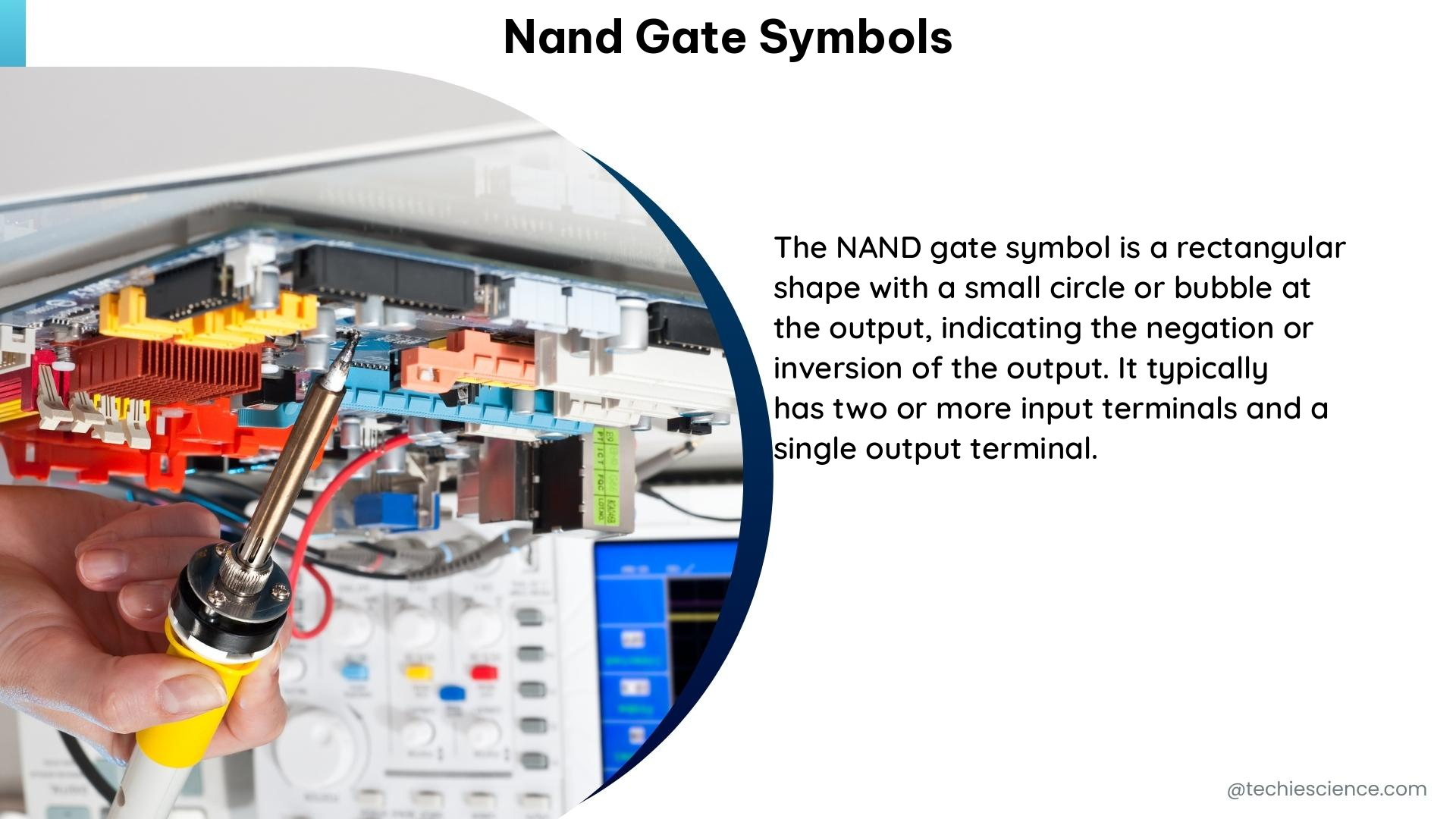NAND gates are fundamental building blocks in digital electronics, widely used in various electronic circuits and systems. This comprehensive guide delves into the technical specifications and symbolic representations of NAND gates, providing electronics students with a deep understanding of this essential logic gate.
Gate-level and Transistor-level Representation of NAND2_X1
The NAND logic function provides a symmetric input relationship, where the output signal is determined whenever one of the inputs is 0. The gate-level and transistor-level representation of the NAND2_X1 gate is shown in Figure 7 of the source material. This figure illustrates the internal structure of the NAND gate, including the arrangement of transistors and the logical connections between the inputs and the output.
NAND Gate Truth Table

The NAND gate produces a 0 output only when both inputs are 1, and it can be thought of as the “NOT AND” operation. The truth table for NAND gates is shown in Table 10.4 of the source material, which clearly demonstrates the output values for all possible input combinations.
| Inputs | Output |
|---|---|
| A | B |
| 0 | 0 |
| 0 | 1 |
| 1 | 0 |
| 1 | 1 |
NAND Gate as a Combination of NOT and AND Gates
The NAND gate is a combination of an AND gate and a NOT gate. The output from the AND gate is inverted or flipped to the opposite state by the NOT gate, resulting in the NAND gate’s characteristic behavior.
NAND Gate versus AND Gate
The key difference between the AND and NAND gates lies in their output behavior. For the AND gate, both inputs must be 1 for the output to be 1 (true). In contrast, for the NAND gate, if both inputs are 1, the output is 0 (false). Otherwise, the NAND gate will output 1 (true).
Symbolic Representation of NAND Gates
NAND gates are typically represented by a circle with the input variables connected to the gate and the output variable at the gate’s output. The symbol for a NAND gate is a combination of the symbols for an AND gate and a NOT gate, as shown in the figure below:

NAND Gate Expression
The Boolean expression for a NAND gate is AB’ + A’B + A’B’, where A and B are the input variables, and B’ and A’ are the negations of B and A, respectively.
Universal NAND Gates
NAND gates are considered universal gates, meaning that any Boolean logic function can be implemented using only NAND gates. This property makes NAND gates highly versatile and widely used in digital circuit design.
Input and Output Voltage Levels
The input voltage level for a NAND gate is typically between 0V and Vcc, where Vcc is the supply voltage. The output voltage level is typically between Vcc and (Vcc/2) for a high output and between (Vcc/2) and 0V for a low output.
Propagation Delay
The propagation delay is the time it takes for the output to change in response to a change in the input. The propagation delay for a NAND gate is typically in the range of a few nanoseconds to a few hundred nanoseconds, depending on the specific technology and design parameters.
Fan-in and Fan-out
The fan-in of a NAND gate is the number of inputs it can accept, while the fan-out is the number of gates that can be driven by its output. The fan-in and fan-out for a NAND gate are typically in the range of 2 to 16, allowing for flexible integration into various digital circuits.
Additional Technical Specifications
- Power Consumption: NAND gates typically have low power consumption, making them suitable for energy-efficient digital designs. The power consumption of a NAND gate can range from a few microwatts to a few milliwatts, depending on the technology and operating conditions.
- Noise Immunity: NAND gates exhibit good noise immunity, which is the ability to tolerate noise or interference without affecting the correct operation of the circuit. This property is crucial in noisy environments or when dealing with high-speed digital signals.
- Switching Speed: The switching speed of NAND gates is generally high, with typical transition times in the range of a few nanoseconds to a few hundred picoseconds. This fast switching capability allows for the implementation of high-speed digital circuits and systems.
- Temperature Range: NAND gates are designed to operate over a wide temperature range, typically from -40°C to +125°C, making them suitable for a variety of applications, including industrial and automotive electronics.
- Packaging: NAND gates are available in various packaging options, such as dual in-line packages (DIPs), small-outline integrated circuits (SOICs), and ball grid arrays (BGAs), allowing for flexible integration into different circuit board designs.
By understanding the technical specifications and symbolic representations of NAND gates, electronics students can effectively design, analyze, and troubleshoot digital circuits and systems that rely on this fundamental logic gate. The comprehensive information provided in this guide will serve as a valuable resource for students to master the intricacies of NAND gate technology.
References:
- Gate-level and transistor-level representation of NAND2_X1
- Electronics Tutorials – NAND Gate
- ScienceDirect – NAND Gate
- Wikipedia – NAND Gate Symbol

The lambdageeks.com Core SME Team is a group of experienced subject matter experts from diverse scientific and technical fields including Physics, Chemistry, Technology,Electronics & Electrical Engineering, Automotive, Mechanical Engineering. Our team collaborates to create high-quality, well-researched articles on a wide range of science and technology topics for the lambdageeks.com website.
All Our Senior SME are having more than 7 Years of experience in the respective fields . They are either Working Industry Professionals or assocaited With different Universities. Refer Our Authors Page to get to know About our Core SMEs.